Snufkin: Melody of Moominvalley is an adventure videogame based on the Moomin characters created by Finnish author and political cartoonist Tove Jansson. The Moomins are bald creatures with pure white skin and bulbous, mouthless faces who reside in Moominvalley, an idyllic region where they live in harmony with the forest, rivers, and animals. I play as Snufkin, a young human-ish man and friend to the Moomins, who returns to Moominvalley after a winter away to find it transformed. A fastidious Moomin called the Park Keeper has transformed large sections of the wild and vibrant valley into suppressed and orderly gardens. Furious at this change, Snufkin sets out into Moominvalley to reunite with his friend Moomintroll, dismantle the gardens, and topple the Park Keeper from his self-appointed authority, tasks that cross his path with more than a dozen of the valley’s fantastic inhabitants.
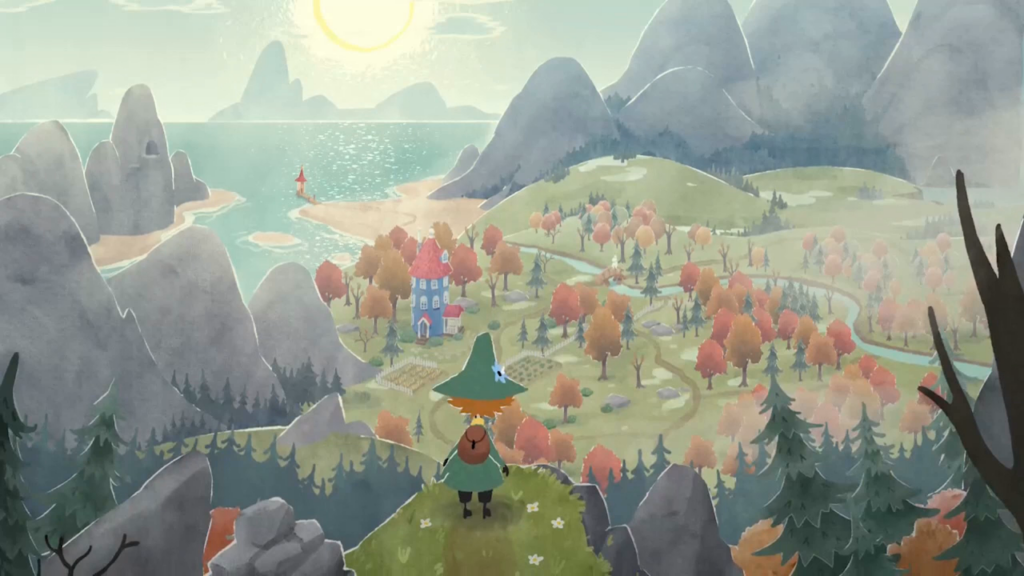
Melody of Moominvalley is a simple videogame that serves as a great introduction to the medium for young children and first-time players, yet is not so dumbed down that the experienced will be disengaged. It creates a cautious balance. In any moment where I might be bored by basic abilities and simple goals, I am entranced by the creativity of the setting and the fantasy of the Moomins and their friends.
Snufkin enters the story returning to Moominvalley from his yearly wintertime wanderings. This creates an initial linear route for him to follow, useful for teaching basic mechanics. I learn to guide Snufkin through the circuitous path of greenery, rendered in lovely visuals that look like they are pulled straight from a children’s storybook. His path grows slightly more complicated over time, teaching me how he can hop between small gaps in the ground and climb along specially textured sections of cliffside wall. These types of environmental movement are second-nature to experienced players and communicated through familiar visual language, but I imagine how they might be revelations to someone who has never played a videogame before. Even as Snufkin’s quest becomes more urgent, he is never rushed. I can take as long as I need to learn how he can move through any particular space.
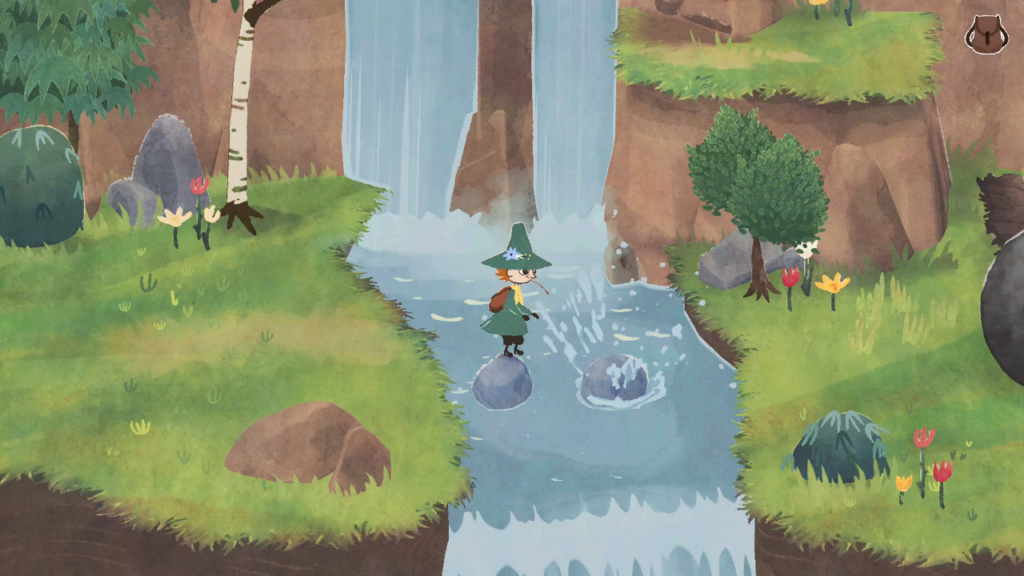
Puzzles grow in complexity as Snufkin nears the entrance to Moominvalley. He must use a stone from a pile as a step up to a high ledge, and then more stones to build a bridge across a wide stream. I expect bridge stones to be automatically arranged in pre-planned patterns, but Snufkin may drop stones in almost any open stretch of water. This freedom is impressive in a videogame of this scale. Creating a bridge from two or three stones in a line is the simplest plan, but there’s nothing stopping me from creating zig-zagging or spiraling bridges if I feel like being fanciful. The engine that supports Melody of Moominvalley’s simple mechanics is deceptively powerful.
Snufkin’s most significant method of interacting with Moominvalley is his musical ability. By holding down a button, I can direct him to play a simple tune on an instrument. This first becomes necessary when he reaches a pond that has no nearby stones available but does have a friendly Sea Creature living inside it. A giant green-skinned serpent with the head of a mustachioed man, when they hear a tune from a harmonica, the Sea Creature happily allows Snufkin to climb onto their head and ferries him across the water. Snufkin adds a few new instruments to his collection across his journey, which expands the number of creatures and objects around Moominvalley that respond to his music.
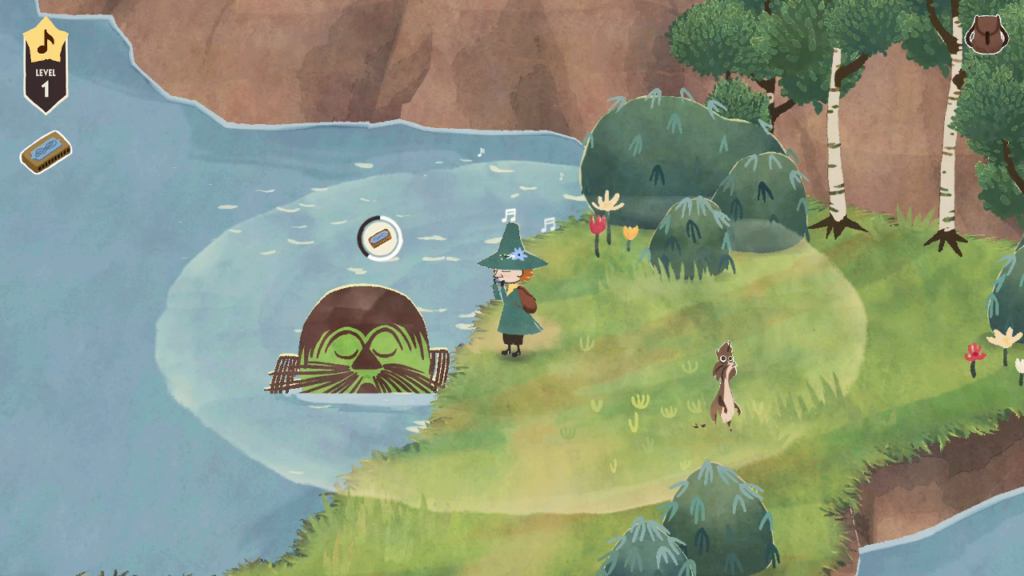
It’s not always enough to have the right instrument. Snufkin must also have the right amount of musical inspiration, a statistic he accumulates through eight different levels and is earned for doing almost anything. The largest amounts are earned by completing tasks for Moominvalley’s residents, but he earns a continuous stream for completing simpler actions as well, like guiding lost bees back to their hives and blowing dandelion seeds off their stems.
This inspiration mechanic is where Melody of Moominvalley feels most artificial. Charging into bushes is an absurd way to induce musical creativity, and yet a large amount of Snufkin’s total inspiration points comes from performing this particular activity dozens of times. I cannot ignore these tiny improvements because many paths leading to Moomintroll and the Park Keeper require minimum inspiration levels. I never find myself roadblocked during my time with Snufkin, but a less thorough player might.
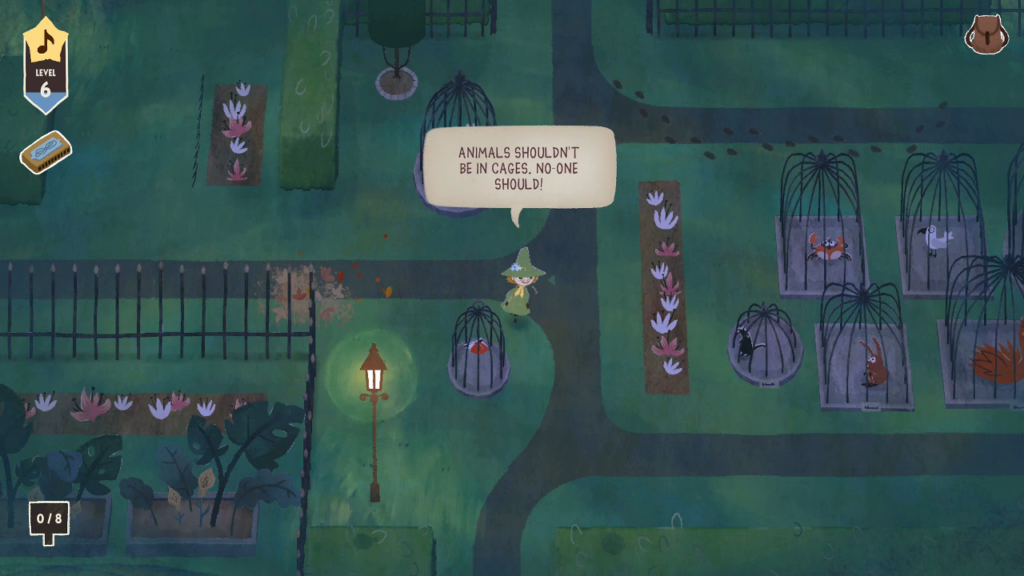
The final obstacle Snufkin encounters before reaching Moominvalley proper is one of the Park Keeper’s gardens. Where the rest of the world is made of open spaces filled with self-guided discoveries and friendly characters, the gardens are surrounded by fences with sharpened posts, force visitors to follow prescribed paths between impenetrable hedges, and are patrolled by the Park Keeper’s loyal and stupid police force. In addition to finding Moomintroll, Snufkin’s broad goal is to discover the locations of these gardens and dismantle them.
Each garden plays like a familiar stealth minigame. To dismantle a garden, Snufkin must pull up all of the Park Keeper’s signs dotted around its interior. Finding every sign can be challenge enough, but the task is made more difficult by patrolling policemen. These agents of the Park Keeper have their field of vision highlighted by a cone of light in front of them. If Snufkin passes through a cone, he is escorted out of the garden or to a nearby checkpoint and must try to sneak through again. Each garden emphasizes a different method of avoiding patrols. Snufkin’s tactics range from simply hiding until a policeman passes by then rushing past, creating distractions by playing music for caged animals, or in one memorable garden, luring its guards to a friendly ghost who scares them away.
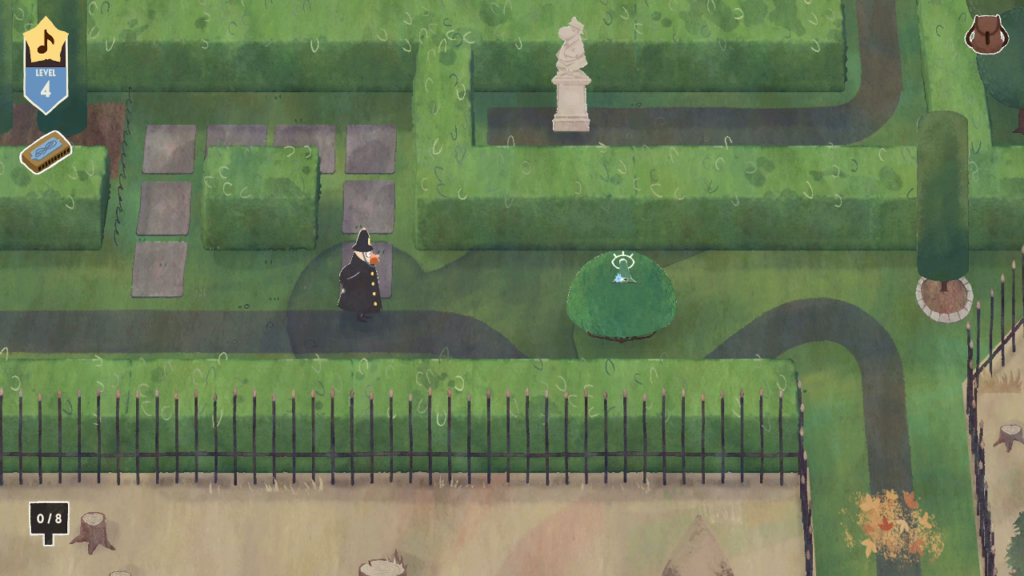
Once I have been taught how Snufkin can move, how he can interact with the valley and its inhabitants, and how to dismantle the Park Keeper’s gardens, he finally arrives in the heart of Moominvalley and the world truly opens up. Right away, he meets Moominmamma and Moominpappa, Moomintroll’s parents. Moominmama’s flower beds have dried up because all the valley’s water is directed to the Park Keeper’s gardens. Moominpapa has composed a play he claims is a masterpiece, but its pages have blown across the valley. Snufkin will inevitably help them with both of these problems before his quest is over.
Though a quest log keeps track of Snufkin’s broad goals, he is free to wander in any direction. This is where I really get to see the breadth of the imaginative characters that appear in Jannson’s books. Snufkin helps a kangaroo-like creature named Sniff find his friend Cedric in a cave filled with irritable crabs. He meets Ninny, an invisible girl, whose clothes have been stolen by Stinky, a ball of brown fuzz with red eyes and antennae. The most memorable character is The Groke, a shambling monster that emits a chilling aura that withers the plants and earth around it while it pursues Snufkin through a tense sequence set at night. Snufkin helps every one of these characters without raising his hand in violence against any person or animal.
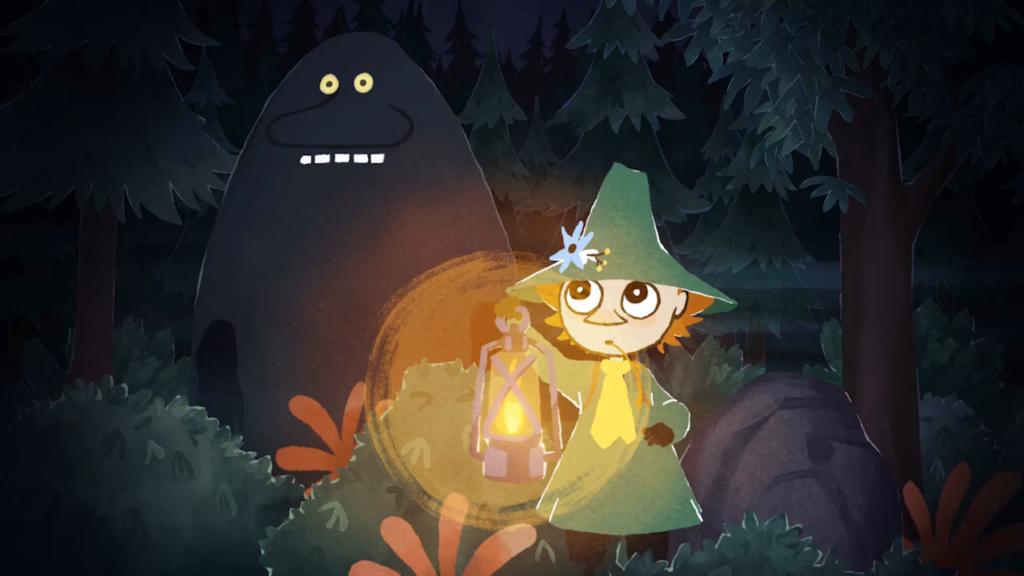
Most of the popular Moomin characters seem to be present in Moominvalley, and each gets a moment to star in their own little story alongside Snufkin’s broader adventure. I only wish the videogame could be a little longer than its four hours so I might get to meet a few more.
Before I played Melody of Moominvalley, I had only the vaguest idea of the Moomins’ existence in popular culture. I recognized the characters, but I did not know what they were called, where they came from, or what they stood for. It is the first piece of Moomin media I have interacted with. Soon after the credits rolled, I realized I would need to do at least some research about the Moomins before I could write this review. Most of my knowledge of the series outside this videogame comes from fan wikis and this article which was recommended to me by a friend. I should not be described as a Moomin expert, or even a fan.
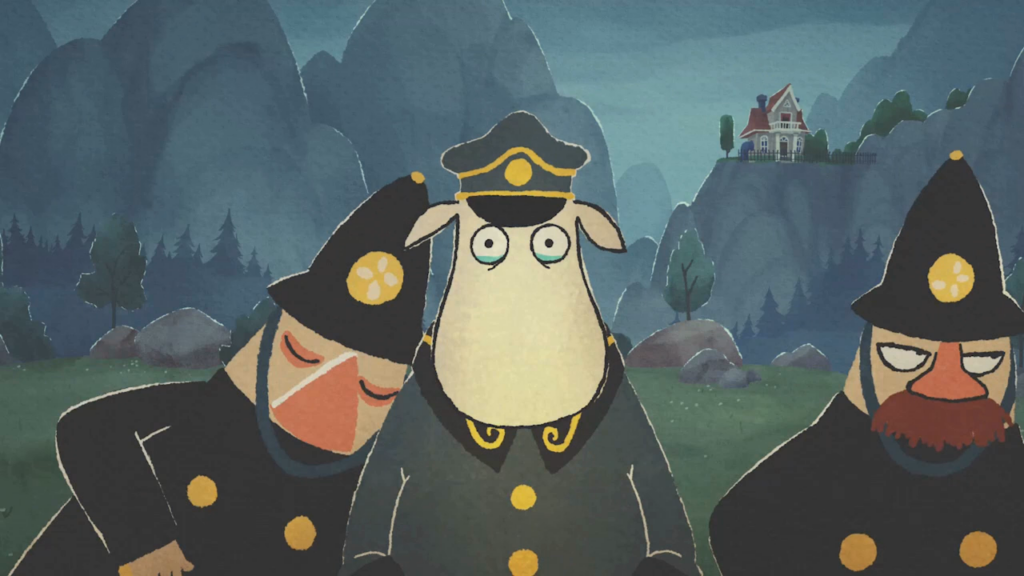
From what I have been able to glean from these resources, I do believe that Moomin fans will be satisfied by Melody of Moominvalley. It exhibits the same characteristics that are the reasons for the characters’ enduring success: Though intended for children, they are appealing to all ages. Apart from being kind and funny, aspects I expect to encounter in media aimed at children, the Moomins possess other, more subversive traits.
More than any other theme in Melody of Moominvalley, I am struck by the distinct anarchist philosophy that runs through its core. Snufkin reacts with confused outrage when he finds the first of the Park Keeper’s signs declaring the outlaw of objects and activities. What is outlawed varies, from logical constraints like open flames and pipes, to nonsensical bans like teapots and fruit, to presumably metaphorical restrictions like hands and eyes. The disparity is part of the point. The Park Keeper’s rules are arbitrary, stifling, and serve only to satisfy his own beliefs and agenda. He’s an authoritarian in a story appropriate for young children, but he’s still an authoritarian.
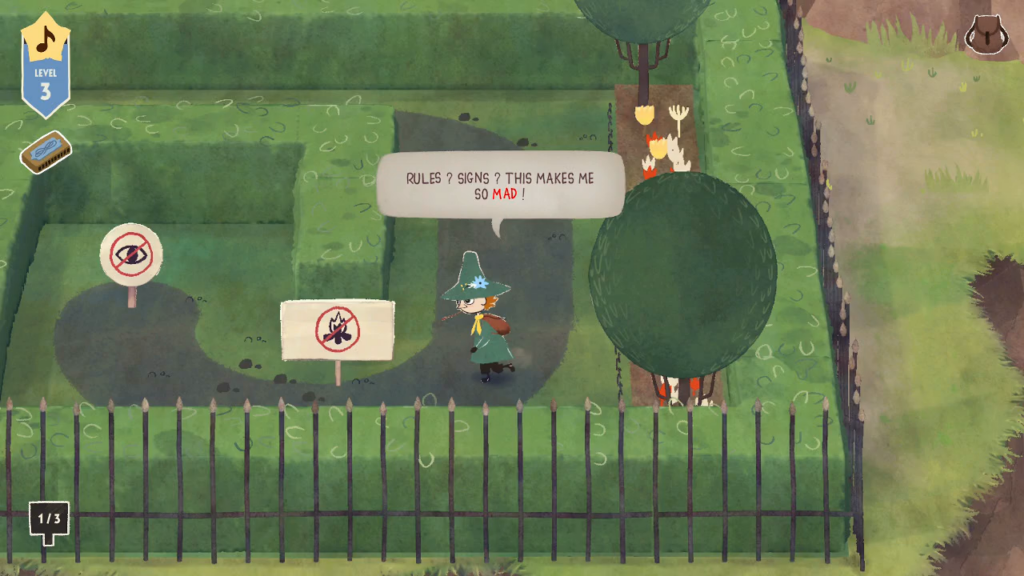
Snufkin’s attempts to dismantle these rules by literally uprooting the signs that establish them is portrayed as an unambiguous good, ultimately restoring life to Moominvalley where the Park Keeper’s gardens are turning it brown and dry. These plot and gameplay elements serve as a child’s introduction to the philosophy that communities thrive when they are not constrained by rules and authority figures. While they may be overly optimistic about the efficacy of Snufkin’s form of pacifist resistance, they are appropriate for all ages and reflect well on Jansson’s antifascist legacy.
Though Snufkin and Moomintroll spend most of the story separated, Snufkin’s driving need to reunite with his friend and the few quiet, intimate moments they do spend together read to me as intensely queer. I was heartened to learn during my research that this is a common interpretation of their relationship across their media appearances and not just a quirk of this adaptation’s particular portrayal. They do not express romantic interest and their only physical contact is mutual support, but I easily interpret their relationship as setting the stage for something more intense once they are older and mature enough to understand it.
While again emphasizing that I knew almost nothing about the Moomins until a short time ago, I perceive Melody of Moominvalley to be a faithful adaptation of the Moomin characters and not just a licensed cashgrab. Fans should not be worried for the characters’ lost integrity before playing this videogame.
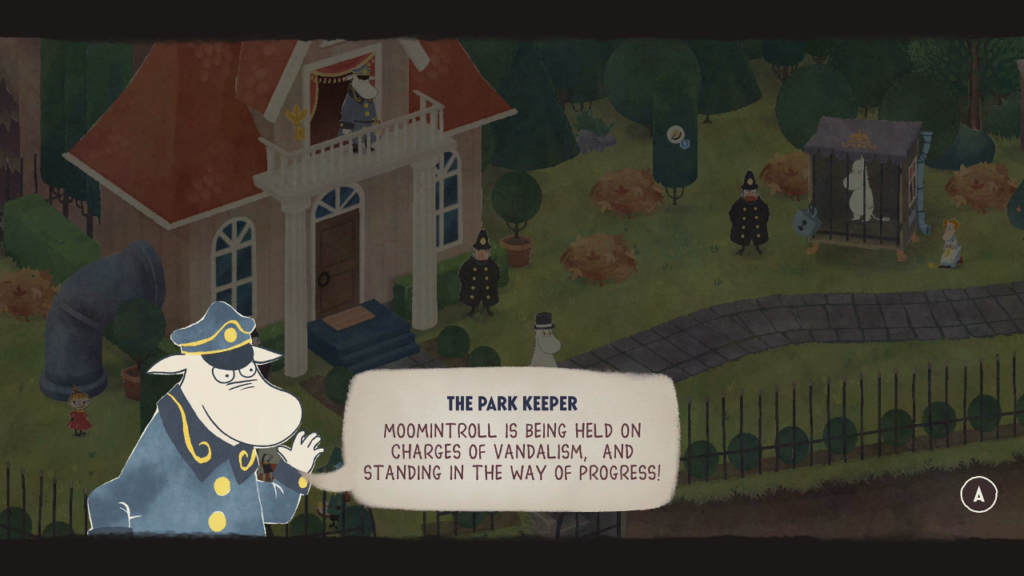
Snufkin: Melody of Moominvalley is a simple, satisfying adventure suitable for all ages and experience levels. It does a wonderful job easing me into its mechanics before setting Snufkin loose in the Moominvalley sandbox to see what quests he can discover. Its anarchist sentimentalities enhance the garden stealth sequences, which might otherwise feel forced, formulaic, overly-mechanical. Only the musical inspiration status levels feel out of place; having to rifle through every bush Snufkin passes for tiny points to fill a meter feels obtrusive where every other activity feels like something that happens every day in Moominvalley. It’s a wonderful little adventure filled with whimsy, optimism, and heart.